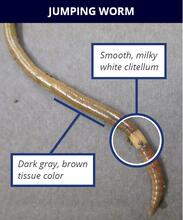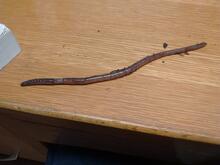Jumping worms, an invasive earthworm making its way across Illinois, have now been confirmed in Morgan County (Jacksonville). Also known as Alabama jumpers, crazy worms, or snake worms, this invasive species is named for its unique, active movements.
Jumping worms were first discovered in Illinois in 2015 and have been spread across the state. As of October 7, 2021, jumping worms have been confirmed in 38 counties and suspected in 6 more.
Identifying jumping worms
Jumping worms are relatively large worms, up to eight inches long. They have a dark body that is darker on top than the bottom and have glossy skin. As their names imply, jumping worms will jump, squirm, flip, and thrash around when disturbed. Their movement can almost appear snake-like as they move in an S-shaped manner.
Jumping worms also have a smooth, milky white clitellum (colored band) that completely circles the body and is not raised. The clitellum starts around the 14th segment, earlier than other species (closer to the front than other worm species).
What makes them worms so bad?
There are currently many unknowns about jumping worms. However, here is some information we do know about them:
- They are voracious consumers of organic matter. Established populations are known to create soil resembling coffee grounds.
- They change the soil structure, deplete available nutrients, damage plant roots, and alter the water holding capacity of the soil.
- The worms are parthenogenic, meaning they can reproduce without mating.
- There is some debate about whether or not adults can survive the winters in central Illinois, but their eggs can. Eggs and young worms can be transported on tools and moved on divided garden plants.
- Jumping worms have the potential to be very destructive in both home landscapes and natural areas.
What can be done about them?
Unfortunately, there are currently no viable control measures for jumping worms. Adult worms can be placed in a plastic bag then placed in the sun to kill them. However, this is unlikely to have a significant impact on jumping worm populations.
Fortunately, there are measures you can take to help prevent the spread of these worms.
- Make sure to thoroughly clean tools and equipment when moving from one site to another.
- Purchase compost and mulch that has been adequately heated to reduce the spread of the eggs. Jumping worm eggs do not survive temperatures over 104°F.
- Avoid transferring or sharing soil, compost, mulch, or plants from garden to garden.
- Carefully inspect new plant material for jumping worms before planting.
- Do not buy jumping worms for bait, vermicomposting, or gardens.
You can monitor for jumping worms in your landscape by mixing a third cup of dry mustard powder with a gallon of water. Pour the solution onto the soil. This will drive all worms in the soil to the surface within a few minutes. This practice will not damage plants or worms but will allow you to identify them.
For more information, see University of Illinois Extension’s Jumping worm factsheet at: https://go.illinois.edu/jumpingworms2021. If you think you found jumping worms, bring a sample to your local Extension office for identification.
WRITER: Ken Johnson, Horticulture Educator, University of Illinois Extension, serving Calhoun, Cass, Greene, Morgan, and Scott counties.
SOURCE: Ken Johnson, Horticulture Educator; Chris Enroth, Horticulture Educator, University of Illinois Extension, serving Henderson, Knox, McDonough, and Warren counties; Chris Evans, Forestry Extension and Research Specialist and Interim Master Naturalist Coordinator, University of Illinois Extension;
ABOUT EXTENSION: Illinois Extension leads public outreach for University of Illinois by translating research into action plans that allow Illinois families, businesses, and community leaders to solve problems, make informed decisions, and adapt to changes and opportunities.

